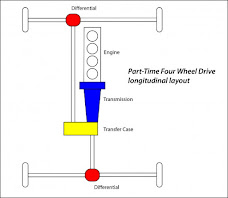Search This Blog
Budget Off-Road Touring

This blog is about sharing our experiences with four-wheel driving and budget touring. We love to explore as much of Australia as possible, but realistically there is plenty of weekend and short trips. Lauren and I love to explore while also showing that you don't need to spend over 100k on a set up to enjoy the great outdoors.
About Me
- Get link
- X
- Other Apps
4WD vs AWD
There is however a variety of reasons why a 4wd is different from an AWD. Before we explore what some of these differences are it is important to mention that are many examples of full-time 4wd systems (such as the 200 series Land Cruiser and the Land Rover Discovery). This is a combination of both the 4wd and AWD system as they utilise the benefits of an AWD when driving on sealed roads, but also have the ability to drive into low traction areas.
Let's start with the Four Wheel Drive system
 |
| Part time 4wd system (Credit Dykes, 2013) |
Let's start with the main key difference between 4wd and an AWD, which is the ability to go into Low Range (4L) on surfaces that have minimal traction. Areas such as steep rock climbs and soft sand are just some of the common areas where low range is best. The low range system changes the gear ratio in order to provide additional torque to the axles, which allows climbing over obstacles a million times easier.
The 4wd system utilises the transfer case to distribute power to each differential 50:50. The power is then distributed by the front and rear diff to each axle, allowing for the vehicle to navigate around obsticles. The issue with this system is that each diff will send power to the axle with the least resistance. In practical terms, when one wheel is lifted off, power will be sent to the one in the air rather then the wheel that is on the ground. This can also be seen in low traction surfaces, as the tyre that cannot grip onto the track will continually spin, while the wheel that is needed to continue pushing the vehicle fowards doesn't move. This downside of many 4wd systems with an open diff can be imporved with a limited slip differential (LSD) or fixed by fitting a locker.
As mentioned, the 4wd system is designed to explore off the beaten track in low traction areas. This differs significantly from the design of the AWD system.
So what is an All Wheel Drive?
 |
| All Wheel Drive System |
The centre diff works with the computer system to send power to the tyre that needs it the most. This allows for the wheels to easily grip on to the road and maintain traction. It is through this ability that AWDs tend to be the safest system on the road, as wheel spin and lost of traction rarely occurs.
What should I purchase?
Well to answer this question, it really depends on what you intend to use your vehicle for. If you don't head off road and would like to have additional safety features then an AWD is what you should pick. However these vehicles are still not 4wds, therefore they don't belong on the tracks (there are many people who will disagree) as these vehicles are not designed for what we put our 4wds through.
For me, I would pick a 4wd. Hence why this is a 4wd and camping blog. The ability to explore parts of our country that the general population will never see is amazing and that's why I love this hobby.
The best of both worlds is in full time 4wds which work as an AWD on the road, then have the ability to undergo hard core offroading as well. However these vehicles usually tend to be heavier on fuel but that is a compormise for the additional safety features.
Now there are definetly pros and cons to each system, however this is the difference between each system in simple terms.
Be sure to check out our Instagram page @budgetoffroadtouring.
The Part time 4wd system diagram used in this post were not created by me. This image can be found at- Alphabet Soup: 4×4 vs 4WD vs AWD Where’s the Differential?



Comments
Post a Comment